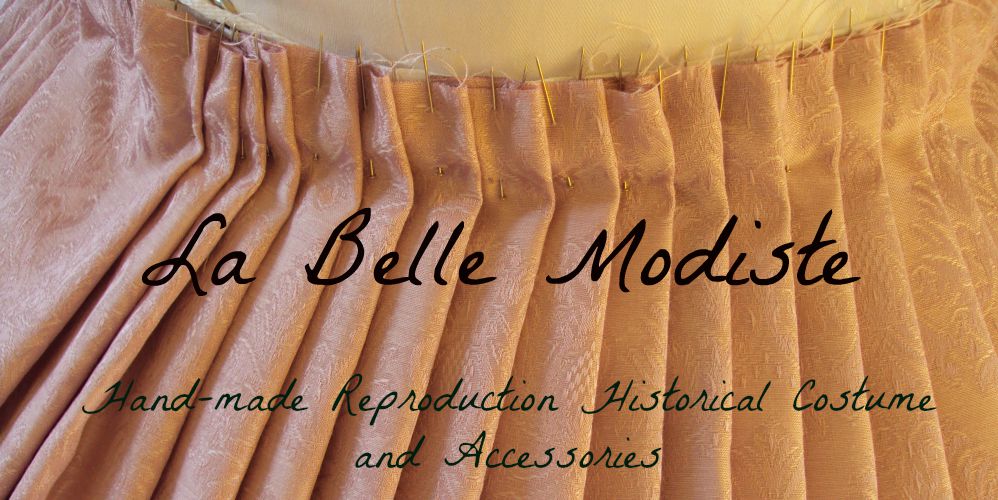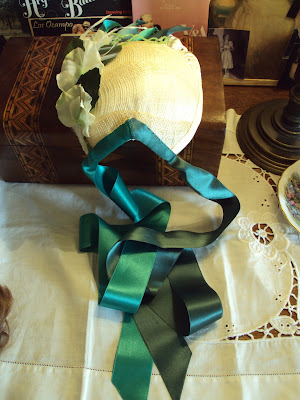Saturday 31 October 2015
Bonnets on sale...
My first three bonnets are now for sale on ebay. See the posts below for the individual links to each ebay page.
Saturday 24 October 2015
Link to sale page
The bonnets have now been uploaded to ebay with the listings scheduled to start at 10:00 Saturday 31st October. My ebay seller name is la_belle-modiste. The link to my items for sale is http://www.ebay.co.uk/sch/la_belle-modiste/m.html?_nkw=&_armrs=1&_ipg=&_from=. At the moment it shows 0 items but the bonnets should hopefully appear at the scheduled time. I will check the link is working next week and update the individual posts with links to the sale pages.
Monday 19 October 2015
An 1880s-1890s small bonnet in cream silk satin and straw with green ribbons - £95
 |
| A bonnet in this typical shape in La Mode Illustrée, April,1886 |
The basic bonnet form is made from two layers of buckram (cotton cloth stiffened with glue and often used for millinery) which are shaped over a head form when wet and then dried and cut to create the final solid shape. The edge of this form is stiffened with wire to help the bonnet maintain its shape.
This form is covered with cream silk satin (padded underneath with an invisible cotton lining). Over this satin base, strips of loosely woven straw fabric have been stitched in decorative bands. Straw was used in many different forms on Victorian bonnets, and although I have used a modern millinery straw of the kind often used to decorate special occasion hats, it is not dissimilar from the sorts of woven straw and horsehair braids that I have seen on original bonnets.
Due to its size and shape, the bonnet it not really designed for any specific headsize. The cupped form should fit the contours of the crown of most heads, and as the pictures show, the bonnet is best worn perched on the back of your hair to create the look of the period. The wig for these photographs was loosely styled after the fashions of the 1880s with much of the length of the hair piled onto the crown. The bonnet was then placed over this and pinned. If your hair is long, I have also found that arranging the back hair into a kind of french pleat provides an effective base to support the bonnet (See the photograph below). The best way to secure this bonnet it using a sturdy hat pin or two.
 |
| This image is for illustrative purposes only - the bonnet in this photograph is not for sale. However, if you would like something similar do not hesitate to contact me at bygoneelegance@gmail.com. |
It will be available to purchase from Ebay on Saturday 31st October at 10am.
I will post a link to the sale page a week in advance (Saturday 24th October)
Tuesday 6 October 2015
An 1862 high-brimmed bonnet in black velvet with red plaid ribbons - £145
 |
| The Ladies Treasury - 1862 |
 |
| The Ladies Treasury - 1862 |
The inside of the brim is decorated with artificial leaves and red and white carnation flowers. These appear very prominent on the mannequin head which is small and solid, but when worn they nestle very nicely between the hair and the bonnet. There is also a deep lace ruffle around the inside of the brim made from high quality English cotton leavers lace. This lace is made "authenticlace" on ebay, a British company that makes Cluny style leavers lace on original machines of the kind that would have been being used to produce machine lace in the 1860s.
 |
| Please note that the ribbons are slightly creased from being tied but will be carefully pressed before being sent - the fabric presses very well |
This bonnet was stitched entirely by hand using the techniques that were employed in the Victorian era.
A band of velvet known as a headstay will be added to the inside of the bonnet that is designed to cling to the hair and help keep the bonnet in place. For windy days or extra security you could also secure the bonnet with bobby pins across the headstay, attach a comb to the headstay or use a hatpin. The choice is yours...
The bonnet is designed to fit an average head size of 22-23 inches. However, as the bonnet sits on the crown of the head this is more flexible than a hat style that encircles the forehead. The polystyrene head in the photographs is quite small and has no hair which is why the bonnet looks a little loose in the photographs.
This bonnet will be priced at £145.00 GBP + postage & packing
It will be available to purchase from Ebay on Saturday 31st October at 10am.
I will post a link to the sale page a week in advance (Saturday 24th October)
Saturday 3 October 2015
An 1860-1862 High-Brimmed Bonnet in shades of lavender/ violet - £140.00
This bonnet is a high-brimmed style suitable for the years 1860-1862 and a great accessory to complete your crinoline era outfit.
The bonnet frame is made from buckram (cotton cloth stiffened with glue and often used for millinery) with a net and wire brim. This method of construction is period correct and also has the advantage that should your bonnet ever get slightly squashed the brim can be gently manipulated back into shape.
The fabric is a light, attractive synthetic damask. Although not period-correct in terms of fibres, this fabric creates a nice period look and does not appear too modern or shiny. The colour is somewhere between lavender and lilac with a slight pinky tinge and is quite accurately produced in the photograph. (However, please be aware that colour can vary significantly from one screen to another).
The inside of the brim in decorated with a ruffle of wide cotton lace, artificial flowers with plastic and wire stems and fabric petals (heather and gypsophila) loops of narrow lace and small lavender-coloured satin bows.
The exterior decoration comprises an arrangement of artificial flowers and leaves.
The bonnet ties are made from two different shades of antique gros grain ribbon that have been sewn to create the wide ties that were fashionable during this period.
The inside of the bonnet is lined with a cotton muslin headlining. This is stitched to the front edge of the headpiece near the brim join and pleated into the back of the bonnet. The back edge is not stitched down - this is the way that original bonnets were lined.
With the exception of the hem on the bavolet (curtain) and the stitching joining the gros grain ribbon this bonnet was stitched entirely by hand using the techniques that were employed in the Victorian era. The use of machine stitching is also acceptable for this period as sewing machines were beginning to be more widely used in the 1860s.
This bonnet is perfect for completing an authentic 1860s outfit and adding that little something extra to your costume. A band of velvet known as a headstay will be added to the inside of the bonnet that is designed to cling to the hair and help keep the bonnet in place. For windy days or extra security you could also secure the bonnet with bobby pins across the headstay, attach a comb to the headstay or use a hatpin. The choice is yours...
The bonnet is designed to fit an average head size of 22-23 inches. However, as the bonnet sits on the crown of the head this is more flexible than a hat style that encircles the forehead. The polystyrene head in the photographs is quite small and has no hair which is why the bonnet looks a little loose in the photographs.
This bonnet will be priced at £140.00 GBP + postage & packing
It will be available to purchase from Ebay on Saturday 31st October at 10am.
I will post a link to the sale page a week in advance (Saturday 24th October)
Welcome!
Hello and welcome to my new blog. Having just completed my Masters degree in Dress and Textile Histories I have decided to begin transforming my passion for making historical costume into a viable career. I have been sewing since I was a little girl and making clothes and costume for myself for the past four or five years. Now I would like to begin to share my creations with a wider audience.
On this blog I will be posting all of my completed costume garments and accessories that will be going up for sale. At the moment these include a small selection of Victorian bonnets but I will be expanding this to include costume and accessories from the 18th century through to the 1950s. I expect to post these on Ebay in the first instance and will post details here as the items become available. The blog posts will act as a preview and items will then be uploaded to Ebay in batches. The date for the next upload to Ebay will be published in each post, so if you are interested in an item you needn't worry about checking back every day to see if it has gone on sale.
My aim is to create pieces that are as true to the spirit and aesthetics of their era as possible but suitable for a wide range of purposes and budgets. As well as 100% period correct reproductions that use only authentic materials and techniques, I also enjoy making more bank-account friendly creations that use carefully selected modern fabrics and embellishments along with machine-stitching where appropriate to create the correct look without the inevitable expense of, for example, a completely hand-stitched 100% silk gown. The choice is up to you and my own costume wardrobe is a balance of the two to suit my budget, needs and timescale.
For me the most important thing is feeling good in costume. Whether that is down to the degree of authenticity, comfort or personal taste in styles doesn't really matter. I aim to create costume that you will be happy and proud to wear.
I am passionate about researching garments thoroughly and always look carefully into the history of an item before starting a new project, using original patterns, fashion plates, portraits, photographs and other sources to enable me to capture the look of a period effectively.
I hope that you enjoy exploring the items that I have on offer as much as I did creating them. If you see something that you like please do not hesitate to contact me for more details, including bespoke requests if, for example, you are looking for a different colour scheme, an authentic reproduction or an item made up in your own materials.
Subscribe to:
Posts (Atom)

































